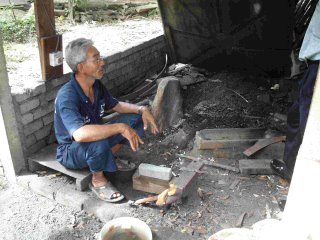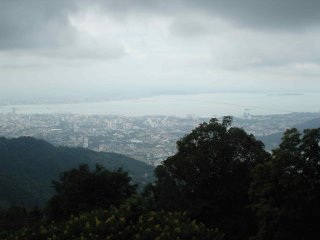Pictures:
a. The artisan who hand crafted the 'Kris' knives of Malaysia.
b. Me, about to ascend Penang Hill.
c. George Town from a lookout in the city
d. The ferry which carried me across to Penang.
e. George Town from the top of Penang Hill.





Malaysia—Penang
Originally, I never in fact planned to visit Penag, it was an idea put into my head by a chance acquaintance on the road (an English traveller by the name of John), and by a desire to break the long train journey to Bangkok.
First, some explanations for those not in the know. Penang is a small island off the coast of northern Malaysia. Its major city is Georgetown, across the water is the neigbouring mainland city of Butterworth. Gtown is a more expensive, tourist city, there are a fair number of visitors and a fair number of expats (largely from the UK) who reside either temporarily or year round on its balmy shores. Transport across is either by ferry or the 13km long (longest in Asia) bridge.
In my mind I thought of Penang as being a sleepy, small town, with a few palm trees and a handful of hotels—nothing could be further from the truth. The town is a growing enterprise with condominions springing up along the coast like weeds. It was only when I ascended Penang Hill (800 metres) and saw the entire city spread out around me that I appreciated the size and diversity of this city (600k people: according to Lonely Planet). It is a vibrant city, yet also friendly and relaxed. I am a little hard pressed to explain this apparent contradiction, but even though people in Penang were usually busy they were never to busy to chat or say hello. Every time I walked past the taxi drivers outside my hotel (a 4 star for A$30 per night! the off season) they said hello and chatted with me for a few moments. In comparison Singapore was a busy and working city, you were definitely a tourist: arrive, see a few sites, and move on: KL was more lively than Sing, but it definitely had that big town feel. Not so Penang.
I spent a total of five days on the island and enjoyed them all. I am almost at a loss to explain what I did. Looking back I can recall the usual tourist activities, and the expected tourist sites, but that still leaves a lot of time unaccounted for. The first day I slept, the second I planned to do my own site seeing but the day began with heavy rain which only got heavier, so I spent most of the day either at Starbucks (with coffee and wireless internet) or in hotel reading and sorting my photos. After that I decided to accept the offer of assistance from a local, a man by the name of Ahmed, who offered to show me around town for a day.
Transportation:
I want to say two things about public transport in Malaysia (this applies to Sing and so far to Bangkok). Everywhere I went, and everyone I spoke to warned my about taxi drivers: they would overcharge, take me on scenic routes, and generally try and scam me. My experience was the total opposite. Every taxi driver, everywhere I went, was curtious, helpful, and honest (mostly). Taxi drivers gave me advice on sites to see, places to visit and where to (and not) to buy things. After my first week abroad I came to rely on these men (so far no female drivers) as my most valued sourse of information. Even when walking past a taxi stand I found that asking a taxi driver gave me the information I needed. So, while I am sure there are unscrupulous drivers out there, this must be a small minority.
The second form of transport I want to discuss is rickshaws. Most people know or have seen these devices, a human powered cart which carries one or two people. In Malaysia (and in a small way Sing) these are tourist attractions, hop on board and a man will pull you around the town. To cut a long story short, after some thought, I decided not to partake of their services. My thinking is that it is undignified and disrespectful to use a human in this way. I realise that this is their job, and they can potentially make a fair sum, but that is my opinion and I will stick to it. Suffice it to say, I did not ride a rickshaw.
More advice:
For those contemplating a trip to SE Asia (or at least the countries I have visited so far) don’t feel a need to bring my travel stuff with you. You buy most items (if not all) much cheaper in Sing or Malaysia. Get off the plan, go to your hotel, and then wander the streets looking for the suburban shopping centres/Malls (not the tourist places): cameras, electronic stuff, bags, etc, will all be cheaper. Of course, if you already have this junk, then no need to worry. Two more but smaller items of advice: carry small denomination US notes ($1 & $5), very handy for tips and small purchases. Second, carry with you a small notebook, to jot down notes and to write instructions for people.
I would recommend a few days for the weary traveller in Penang.
Onwards to Thailand!
a. The artisan who hand crafted the 'Kris' knives of Malaysia.
b. Me, about to ascend Penang Hill.
c. George Town from a lookout in the city
d. The ferry which carried me across to Penang.
e. George Town from the top of Penang Hill.





Malaysia—Penang
Originally, I never in fact planned to visit Penag, it was an idea put into my head by a chance acquaintance on the road (an English traveller by the name of John), and by a desire to break the long train journey to Bangkok.
First, some explanations for those not in the know. Penang is a small island off the coast of northern Malaysia. Its major city is Georgetown, across the water is the neigbouring mainland city of Butterworth. Gtown is a more expensive, tourist city, there are a fair number of visitors and a fair number of expats (largely from the UK) who reside either temporarily or year round on its balmy shores. Transport across is either by ferry or the 13km long (longest in Asia) bridge.
In my mind I thought of Penang as being a sleepy, small town, with a few palm trees and a handful of hotels—nothing could be further from the truth. The town is a growing enterprise with condominions springing up along the coast like weeds. It was only when I ascended Penang Hill (800 metres) and saw the entire city spread out around me that I appreciated the size and diversity of this city (600k people: according to Lonely Planet). It is a vibrant city, yet also friendly and relaxed. I am a little hard pressed to explain this apparent contradiction, but even though people in Penang were usually busy they were never to busy to chat or say hello. Every time I walked past the taxi drivers outside my hotel (a 4 star for A$30 per night! the off season) they said hello and chatted with me for a few moments. In comparison Singapore was a busy and working city, you were definitely a tourist: arrive, see a few sites, and move on: KL was more lively than Sing, but it definitely had that big town feel. Not so Penang.
I spent a total of five days on the island and enjoyed them all. I am almost at a loss to explain what I did. Looking back I can recall the usual tourist activities, and the expected tourist sites, but that still leaves a lot of time unaccounted for. The first day I slept, the second I planned to do my own site seeing but the day began with heavy rain which only got heavier, so I spent most of the day either at Starbucks (with coffee and wireless internet) or in hotel reading and sorting my photos. After that I decided to accept the offer of assistance from a local, a man by the name of Ahmed, who offered to show me around town for a day.
Transportation:
I want to say two things about public transport in Malaysia (this applies to Sing and so far to Bangkok). Everywhere I went, and everyone I spoke to warned my about taxi drivers: they would overcharge, take me on scenic routes, and generally try and scam me. My experience was the total opposite. Every taxi driver, everywhere I went, was curtious, helpful, and honest (mostly). Taxi drivers gave me advice on sites to see, places to visit and where to (and not) to buy things. After my first week abroad I came to rely on these men (so far no female drivers) as my most valued sourse of information. Even when walking past a taxi stand I found that asking a taxi driver gave me the information I needed. So, while I am sure there are unscrupulous drivers out there, this must be a small minority.
The second form of transport I want to discuss is rickshaws. Most people know or have seen these devices, a human powered cart which carries one or two people. In Malaysia (and in a small way Sing) these are tourist attractions, hop on board and a man will pull you around the town. To cut a long story short, after some thought, I decided not to partake of their services. My thinking is that it is undignified and disrespectful to use a human in this way. I realise that this is their job, and they can potentially make a fair sum, but that is my opinion and I will stick to it. Suffice it to say, I did not ride a rickshaw.
More advice:
For those contemplating a trip to SE Asia (or at least the countries I have visited so far) don’t feel a need to bring my travel stuff with you. You buy most items (if not all) much cheaper in Sing or Malaysia. Get off the plan, go to your hotel, and then wander the streets looking for the suburban shopping centres/Malls (not the tourist places): cameras, electronic stuff, bags, etc, will all be cheaper. Of course, if you already have this junk, then no need to worry. Two more but smaller items of advice: carry small denomination US notes ($1 & $5), very handy for tips and small purchases. Second, carry with you a small notebook, to jot down notes and to write instructions for people.
I would recommend a few days for the weary traveller in Penang.
Onwards to Thailand!
Comments